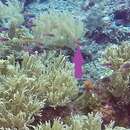Diagnostic Description
provided by Fishbase
Looks blue with dark yellow over the back when seen in natural light. Unlike most other basslets, the dorsal fins are in two parts (Ref. 48635).Description: Characterized by having narrow magenta margin on dorsal and ventral edge of caudal fin; greatest depth of body 3.3-3.8 in SL; lunate caudal fin; relatively long paired fins, pectorals 3.2-3.5 and pelvics 3.7-4.7 in SL (Ref. 90102).
- Recorder
- Cristina V. Garilao
Morphology
provided by Fishbase
Dorsal spines (total): 10; Dorsal soft rays (total): 15 - 16; Analspines: 3; Analsoft rays: 7
- Recorder
- Cristina V. Garilao
Trophic Strategy
provided by Fishbase
From external regions of coral reefs of the West Pacific Region (Ref. 9137).
- Recorder
- Drina Sta. Iglesia
Biology
provided by Fishbase
Usually in groups on outer reef slopes (Ref. 27115). Most commonly occurs in shallow water and most likely seen by divers (Ref. 37816). Forms dense aggregations that feed on zooplankton (Ref 90102).
- Recorder
- Estelita Emily Capuli
Importance
provided by Fishbase
aquarium: commercial
- Recorder
- Estelita Emily Capuli
Description
provided by World Register of Marine Species
Usually in groups on outer reef slopes.
Froese, R. & D. Pauly (Editors). (2023). FishBase. World Wide Web electronic publication. version (02/2023).
- license
- cc-by-4.0
- copyright
- WoRMS Editorial Board

